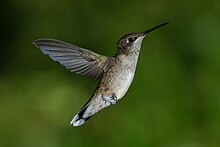
Hi Everybody!!
Today I still have 6 little birds. I do not expect any new ones to come in, but as you know, they do not make reservations! The photos below are from August 26. All of the pics show feeders without perches. The birds go into the port and suck, then back up and hover, then back into the port. In other words, they are in constant movement around this type of feeder. I have tried to display all positions of the birds throughout the August photostudies so you are aware of how they move in these shots with single birds. All of September Posts will reflect many birds swarming all the feeders. Stay tuned and enjoy!


















Links to Album photostudy:
https://plus.google.com/u/0/photos/117645114459863049265/albums/6064976578637178321
https://plus.google.com/u/0/photos/117645114459863049265/albums/6064978345162060977

Male Ruby-throated Hummingbird chirping!
https://en.wikipedia.org/wiki/Ruby-throated_hummingbird
| Ruby-throated hummingbird | |
|---|---|
 | |
| Conservation status | |
| Scientific classification | |
| Kingdom: | Animalia |
| Phylum: | Chordata |
| Class: | Aves |
| Order: | Apodiformes[2] |
| Family: | Trochilidae |
| Genus: | Archilochus |
| Species: | A. colubris |
| Binomial name | |
| Archilochus colubris (Linnaeus, 1758) | |
 | |
| Summer-only range Winter-only range Migratory path | |
Description[edit]
The ruby-throated hummingbird is the smallest bird species that breeds in the Eastern United States andEastern Canada. This hummingbird is from 7 to 9 cm (2.8 to 3.5 in) long and has an 8 to 11 cm (3.1 to 4.3 in) wingspan. Weight can range from 2 to 6 g (0.071 to 0.212 oz), with males averaging 3.4 g (0.12 oz) against the slightly larger female which averages 3.8 g (0.13 oz).[3][4] Adults are metallic green above and greyish white below, with near-black wings. Their bill, at up to 2 cm (0.79 in), is long, straight, and very slender. As in all hummingbirds, the toes and feet of this species are quite small, with a middle toe of around 0.6 cm (0.24 in) and a tarsus of approximately 0.4 cm (0.16 in). The ruby-throated hummingbird can only fox-trot if it wants to move along a branch, though it can scratch its head and neck with its feet.[5][6]
The species is sexually dimorphic.[7] The adult male has a gorget (throat patch) of iridescent ruby red bordered narrowly with velvety black on the upper margin and a forked black tail with a faint violet sheen. The red iridescence is highly directional and appears dull black from many angles. The female has a notched tail with outer feathers banded in green, black, and white and a white throat that may be plain or lightly marked with dusky streaks or stipples. Males are smaller than females and have slightly shorter bills. Juvenile males resemble adult females, though usually with heavier throat markings.[8] The plumage is molted once a year, beginning in late summer.
Flight[edit]
Hummingbirds have many skeletal and flight muscle adaptations which allow great agility in flight. Muscles make up 25–30% of their body weight, and they have long, blade-like wings that, unlike the wings of other birds, connect to the body only from the shoulder joint.[14] This adaptation allows the wing to rotate almost 180°, enabling the bird to fly not only forward but backward, and to hover in mid-air, flight capabilities that are similar to insects and unique among birds.[14] Hummingbird hovering has been estimated to be 20% more efficient than performed by ahelicopter drone.[15]
Analysis of the main wing bone, the humerus, is thought to be specifically adapted for hovering flight. Hummingbirds have a relatively short humerus with proportionally massive deltoid-pectoralmuscles which permit pronounced wing supination during upstroke when hovering.[16]
A hummingbird's ability to hover is due to its small mass, high wingbeat frequency and relatively large margin of mass-specific power available for flight. Several anatomical features contribute further, including proportionally massive major flight muscles (pectoralis major and supracoracoideus) and wing anatomy that enables the bird to leave its wings extended yet turned over (supine) during the upstroke. This generates lift that supports body weight and maneuvering.[17]
Hummingbirds achieve ability to support their weight and hover from wing beats creating lift on the downstroke of a wing flap and also on the upstroke in a ratio of 75%:25%, respectively, similarly to an insect.[17][18] Hummingbirds and insects gain lift during hovering partially through inversion of their cambered wings during an upstroke.[18] During hovering, hummingbird wings beat up to 80 times per second.[15]
(Please see above link for complete article)
(Please see above link for complete article)





Female ruby-throated Hummingbird

O+O



No comments:
Post a Comment